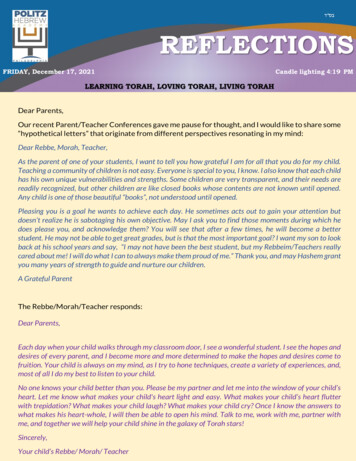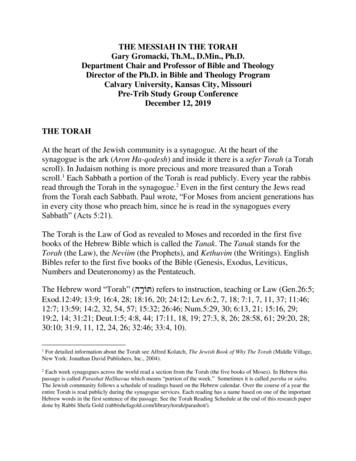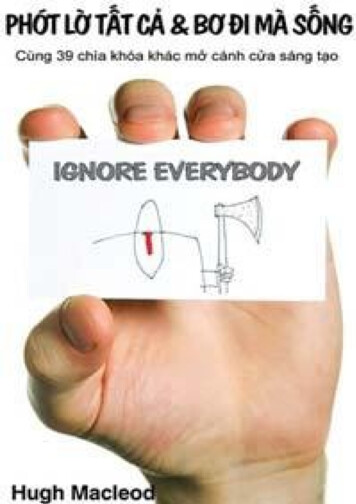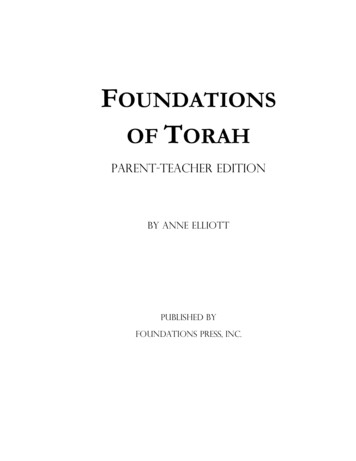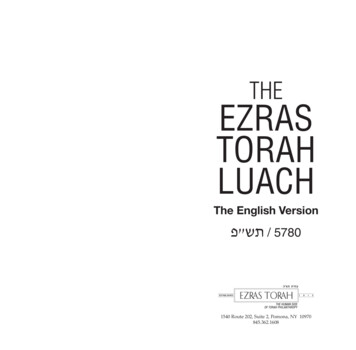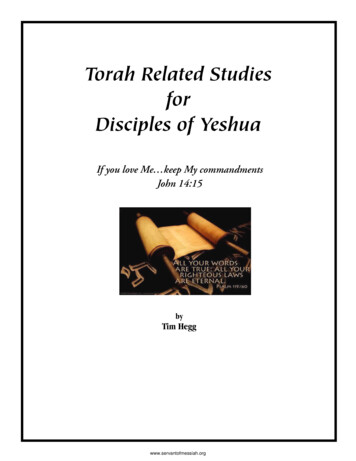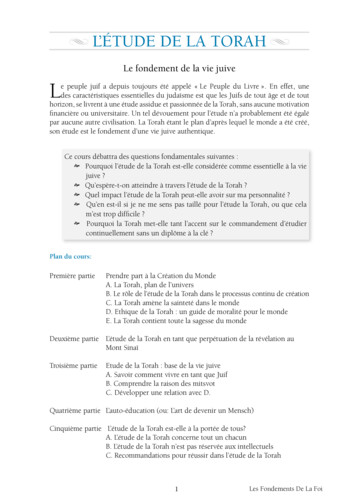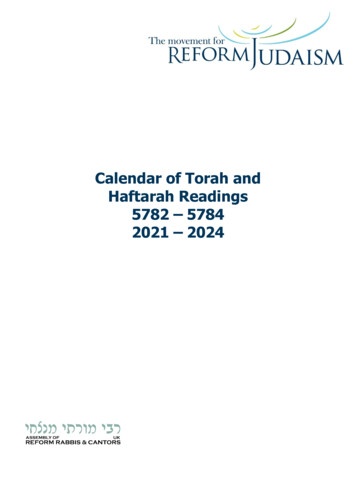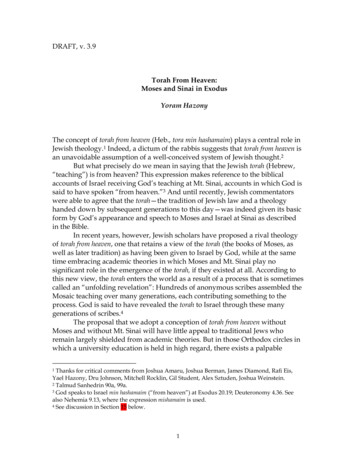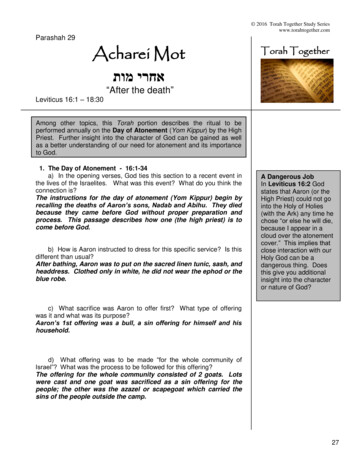
Transcription
2016 Torah Together Study Serieswww.torahtogether.comParashah 29Acharei MotTorah Together אחרי מות “After the death”Leviticus 16:1 – 18:30Among other topics, this Torah portion describes the ritual to beperformed annually on the Day of Atonement (Yom Kippur) by the HighPriest. Further insight into the character of God can be gained as wellas a better understanding of our need for atonement and its importanceto God.1. The Day of Atonement - 16:1-34a) In the opening verses, God ties this section to a recent event inthe lives of the Israelites. What was this event? What do you think theconnection is?The instructions for the day of atonement (Yom Kippur) begin byrecalling the deaths of Aaron’s sons, Nadab and Abihu. They diedbecause they came before God without proper preparation andprocess. This passage describes how one (the high priest) is tocome before God.b) How is Aaron instructed to dress for this specific service? Is thisdifferent than usual?After bathing, Aaron was to put on the sacred linen tunic, sash, andheaddress. Clothed only in white, he did not wear the ephod or theblue robe.A Dangerous JobIn Leviticus 16:2 Godstates that Aaron (or theHigh Priest) could not gointo the Holy of Holies(with the Ark) any time hechose “or else he will die,because I appear in acloud over the atonementcover.” This implies thatclose interaction with ourHoly God can be adangerous thing. Doesthis give you additionalinsight into the characteror nature of God?c) What sacrifice was Aaron to offer first? What type of offeringwas it and what was its purpose?Aaron’s 1st offering was a bull, a sin offering for himself and hishousehold.d) What offering was to be made “for the whole community ofIsrael”? What was the process to be followed for this offering?The offering for the whole community consisted of 2 goats. Lotswere cast and one goat was sacrificed as a sin offering for thepeople; the other was the azazel or scapegoat which carried thesins of the people outside the camp.27
2016 Torah Together Study Serieswww.torahtogether.comThe ScapegoatIn Leviticus 16:8, theHebrew word oftentranslated as scapegoatis azazel, which literallymeans “goat of departureor removal.” The ritualdescribed in Leviticus16:20-22 then assures theremoval of all the sins ofthe Israelites from thecommunity. (In practice,the scapegoat wasusually pushed off a steepcliff, assuring death andeliminating the possibilityof the goat’s return.)The term azazel hasbecome the topic of somedebate. Some believethat it is the name of afalse god or demon ofsatan. Others believe it isthe name of one of thefallen angels referred to inGenesis 6:1-2. Stillothers think it refers to thespecific rugged mountaincliff from which the goatwas cast down.28e) Verse 2 explains the danger to Aaron (or the high priest) whenhe goes into the Most Holy Place. What, according to verse 13, is hesupposed to do to prevent this? What else does he do in the Most HolyPlace at this time?If Aaron (or the high priest) was present before the mercy seat onthe ark of the covenant in the Most Holy Place as God appearedabove it, he would die. (Note that the cover for the ark is called thekapporet or atonement cover.) To prevent this, he was to first takea censer with incense behind the curtain so that the smoke wouldconceal the atonement cover. Then he was to sprinkle some of theblood from the bull (his sin offering) on the atonement cover andseven times before the atonement cover.f) After Aaron had made atonement for himself and his family, whatdid he do with the goat to which God’s lot fell? What was the purposefor this? Who helped Aaron in the Tent?The goat to which God’s lot fell was slaughtered as a sin offeringfor the people and it’s blood was taken to the Most Holy Place andsprinkled on the atonement cover as was done with Aaron’s sinoffering. This was also done for the Tent of Meeting and for theAltar of Burnt Offering. The purpose was to make atonement forthe “uncleanness and rebellion of the Israelites” (verse 16). He wasto do this alone.g) Explain the procedure to be followed with the second goat afterAaron had completed the sacrifices for himself and for the Israelites.What symbolism do you see in this?The high priest (Aaron) was to lay his hands on the head of thegoat and confess the sins of the Israelites, thereby transferringthem to the goat. A man (traditionally another priest) was to takethe goat outside the camp into the desert where it was to bereleased (presumably to die). (Traditionally, the goat was pushedoff a cliff and its death was assured.)h) What did both Aaron and the man who released the scapegoathave to do as they completed their tasks for atonement? What wasdone with the carcasses of the two animals that were sacrificed foratonement? Why do you think this was done?Both Aaron and the man who took the goat into the wilderness hadto bathe before continuing their normal duties. The carcasses ofthe bull and the sacrificial goat were to be burned up outside thecamp.
2016 Torah Together Study Serieswww.torahtogether.comi) When was the atonement ceremony to be held? What were theIsraelites required to do on this day? Do you think believers couldbenefit by observing this today?The Day of Atonement was to be the 10th of Tishri, the 7th month.The Israelites were required to “deny themselves” which is usuallytaken to mean fast for the day. This seems to be a meaningfulritual even today in recognition of the atoning sacrifice of Yeshuaon our behalf.“This is to be a lasting ordinance for you: Atonement is to be madeonce a year for all the sins of the Israelites.”Leviticus 16:342. Eating Blood Forbidden - 17:1-15a) According to the first several verses, where were all animalsacrifices to be carried out? When an Israelite sacrificed an animal,what type of offering was it to be? What was the punishment fordisobedience?What do you think God’s purpose was for thiscommandment?This command concerned only animals that were to be killed as asacrifice (korban) to God.All such offerings were to beslaughtered by the priest at the entrance to the tent of meeting asfellowship or peace offerings.An offender was “guilty ofbloodshed” and was to be “cut off from his people.” In verses 5and 7 God gives an indication that this was to eliminate anysacrifices to other gods.b) God seems to be quite serious about the commandment not toeat blood. What reason is given for this? Does this make sense to you?What happened to one who disobeyed this commandment?In verse 10, God says that He himself will cut off the person whoeats blood. The life of the animal is in the blood and God has givenit to the people to make atonement for their lives (verse 11). Thejust punishment for sin is death but God has graciously allowed ananimal to die in our place. The animal’s spilled blood is proof thatit gave its life for our sin.3. Unlawful Sexual Relations - 18:1-30a) As this passage opens, which societies does God caution theIsraelites not to copy? What were they to do instead? Why?The Israelites were not to follow the customs of the Egyptians orthe Canaanites. Instead they are to obey God’s laws, to live bythem. They had made a covenant with God and promised to obeyhis commands.Scripture Link:God is not commandingthat all meat come fromanimals sacrificed to him.However, no animalsacrifice was to be madeanywhere but at theTabernacle.Deuteronomy 12:20-26makes it clear that anIsraelite may slaughter ananimal for food whereever he chooses.However, these are not tobe considered asofferings to God.What’s so special aboutBlood?It’s clear that God placesspecial value on blood.From the very beginning,we know that the result ofsin is death. (Genesis2:17) When Adam andEve first sinned, Godgraciously allowed themto substitute the life of ananimal in place of theirown. It was the blood ofthis animal that providedthe proof that a life hadbeen given to atone fortheir sin. God considersALL life sacred and fromHis perspective, “the life isin the blood.” (Leviticus17:11, Deuteronomy12:23) Eating blood thenprofanes that which Godconsiders sacred.29
2016 Torah Together Study Serieswww.torahtogether.comThe Day of AtonementThe Day of Atonement (Yom Kippur) is the holiest day of the year on theHebrew calendar. It is observed on Tishri 10, which typically occurs in lateSeptember or early October. It is the only appointed time (mo’ed) of Godthat is not celebrated with a feast. Instead, believers are to “denythemselves and not do any work ” (Leviticus 16:29). To deny one’s selfis commonly understood to mean to fast. Thus observers typically spendthe day (starting at sundown on Tishri 9) in prayer and fasting. The tendays from Yom Teruah to Yom Kippur (Tishri 1 – 10) are known as theDays of Awe. During this period, believers reflect on their sins during thepast year and seek forgiveness from anyone that they have wronged. Theyare then to repent (teshuvah in Hebrew) and return to God’s ways so thaton the Day of Atonement, these sins can be atoned for. Thus, on YomKippur, atonement (or payment) is made for the sins of the believer andthey are forgiven so that they may rededicate themselves to living a lifepleasing to God.AtonementThe Hebrew for both thewords kippur andkapporet come from aroot that means “to coveror hide.” By extension, itcan also mean to “coveror pay for sin.” God hasmercifully allowed us to“pay for” or “makeatonement for” our sin.Can you see theconnection between YomKippur, the Day ofAtonement and theKapporet, or Mercy Seat?Also, the small (usuallyblack) head coveringtypically worn by religiousJewish men is called a“kippah.” Can you seehow this name isappropriate for thisobject?30When the Tabernacle (and the Temple) existed, this was the one time ofthe year when the High Priest would enter the Holy of Holies which housedthe Ark of the Covenant. His task was to present the blood of the offeringmade for the atonement of the sins of the people. He was to sprinkle theblood of the animal (that had given its life as a substitute for the people topay for, or atone, for their sin) on the cover of the Ark of the Covenant. Thiscover, fashioned from pure gold, was known as the Atonement Cover(kapporet in Hebrew). It was in a cloud above this cover that God wouldappear to the High Priest (Leviticus 16:2).
2016 Torah Together Study Serieswww.torahtogether.comb) List some of the restrictions placed on sexual relations. Giventhe instructions in the these verses, what can you conclude about theneighboring cultures?There were to be no sexual relations with close relatives: mother,father’s wife, aunts, sisters, sisters-in-law, daughters, daughters-inlaw, etc. These were obviously some of the practices of theEgyptians and the Canaanites.c) Can you think of any examples from the Bible in which theseinstructions were violated?What can you conclude from theseexamples?Rueben had sexual relations with his father Jacob’s concubine,Bilhah (Genesis 35:22). Judah had relations with his (dead) son’swife, Tamar (Genesis 38). Jacob married two sisters which causedmany problems. (Verse 18 strongly suggests monogamy.) Also, itwas common for Egyptian siblings to marry and the Canaanitespracticed child sacrifice to Molech.d) Is there any doubt about God’s view of homosexuality?If it hadn’t been clear from the destruction of Sodom andGomorrah, God makes it clear in verse 22 that homosexuality is“detestable.”e) In verses 24 through 30, how does God describe thesepractices? What did these practices do to the people that lived in theland? What was the effect on the land? What did “the land” do? Canyou see how this might tie into Genesis 15:16?God calls these practices “detestable” and says that the currentinhabitants had become “defiled” and the land itself had become“defiled.” The land would “vomit out” or “disgorge” these nationsbefore the Israelites. In Genesis 15:16, God said to Abraham that“the sin of the Amorites had not yet reached its full measure.”These may have been the sins of the Amorites.Detestable to GodIn Leviticus 18:24-28,God explains how hefeels about these sexualpractices: they aredetestable and defile theperson and the land. Godhad judged the previousinhabitants of the land ofCanaan for thesepractices and used theIsraelites as theinstrument of hispunishment. This is whyIsrael has a “legal right” tothe land. Furthermore,God explained that if theIsraelites defiled the landin this way, they too wouldbe punished (exiled or“vomited out” of the land).Sadly, history shows thatthis is exactly whathappened.f) Were these laws for the Israelites only? What was to be donewith someone who .violated these laws? What do you think this meant?These laws were for the Israelites and the aliens living among them,i.e., Hebrew converts. One who disobeyed was to be “cut off fromtheir people,” probably put outside the camp and not allowed backin.31
2016 Torah Together Study Serieswww.torahtogether.comDigging deeper . . . .1. Yom Kippur, or the Day of Atonement, was clearly an important dayfor the Israelites. See how many parallels you can find between theceremony followed on Yom Kippur and the sacrifice of Yeshua.Many parallels are possible. Yeshua took the sins of the world onhis head and was killed outside the camp (city). It was through hissacrifice that believers could be in right standing before God, themeaning of atonement.2. In the original Hebrew, the name for the second goat, or thescapegoat, is Azazel. There are several schools of thought as to themeaning of this word. See what you can discover about Azazel.Azazel is thought to be a) the term for the second goat orscapegoat, b) the name of the place where the goat was taken todie (meaning “a land which is cut off”), or c) the name of one ofsatan’s demons to which the sins of the people were returned.3. Leviticus 17:11 states God’s view of an animal’s blood. Hebrews 9also has a lot to say about blood. Starting at the beginning of the Bibleand focusing just on blood, list some of the teachings that you feel areimportant about blood.One interesting thought goes like this: When Adam and Eve sinnedin Eden, God sacrificed an animal for each individual to provideclothing. Next, when the angel of death passed over Egypt killingthe first born, a lamb was sacrificed for each family. Then, onceeach year at Yom Kippur, an animal was sacrificed for the sins ofthe nation of Israel. Finally, Yeshua was sacrificed for the sins ofthe entire world. The main point is that the just punishment for sinis death and death occurs when an animal (human or otherwise) isparted from its blood. The blood is the witness of the death of theanimal which is required because of sin.For further study, seeHaftarah : Jeremiah 46:13-28Brit Hadashah : Luke 2:22-24; John 19:31-37; Acts 13:16-17;Revelation 8:6 – 9:12; 16:1-2132
Among other topics, this Torah portion describes the ritual to be performed annually on the Day of Atonement (Yom Kippur) by the High Priest. Further insight into the character of God can be gained as well as a better understanding of our need for atonement and its importance to God. .

